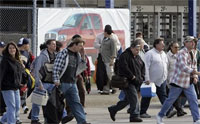Substantial Overhead Costs
 The scope of the agreement and nature of the relationship adds huge overhead costs to the OEMs, Robinson says. The scope of the agreement and nature of the relationship adds huge overhead costs to the OEMs, Robinson says.
“Both the UAW and the Detroit Three maintain large staffs of lawyers, contract administrators, and financial and human-resources representatives whose principal job is to negotiate with the other side,” Robinson says. “These staffs are at all levels, from the factory floor to corporate headquarters and the UAW's "Solidarity House" in downtown Detroit.”
Not only does this add huge costs, it makes decision-making and executing even small changes painfully slow and difficult. The non-unionized plants at Honda, Toyota, etc., simply do not have these costs or operational barriers in their operations.
“If the company asks to change the flow of work for any reason, from cost-savings to vehicle improvements, the local union president will listen politely, and then say something like, "We can help you with this, but what's in it for my guys?"” Robinson says.
These mutually sustaining bureaucracies exist to negotiate with each other, Robinson adds. In many cases, even as plants or distribution centers are consolidated, they remain “open,” lit and heated simply to preserve the spots for the local union president and UAW staff – a “jobs bank” of sorts for union leadership.
Eating Auto Executives for Lunch
The need to keep peace with the union is also a strong obstacle to effective company management at the automakers, Robinson says.
“The Detroit CEOs indulge the head of the UAW as they would a boss, because, like a boss, he can make or break their careers,” Robinson says. He notes that the predecessor to the current and generally respected UAW president Ron Gettlefinger, a man named Steve Yokich, “ate vice presidents for breakfast, and many promising former executives learned this the hard way.”
“As the Obama administration takes the helm, the key political question is whether the Democratic Party, which has so benefited from union support, will have the courage to push the UAW into a more reasonable relationship with the Detroit Three,” Robinson concludes. “If the Obama administration does not force the UAW to make further concessions, it will not be able to save the Detroit Three, no matter how many green cars they roll off the assembly line.”
Are the UAW work rules and restrictions a key factor in the troubles of Detroit’s Big Three? Can they survive if these contract requirements are not brought in line with the non-unionized auto transplants? How does all this factor in to the proposed “card check” change? Let us know your thoughts at the Feedback button below.
|